|
|
|
I first heard of Tibetan debate a long time ago
when I was reading the Dalai Lama's autobiography. Debate
is a big part of a monk's education, and it is the examination
by which they receive their lama degrees. During the cham,
the interpreter was amusingly telling us that the object of a
debate is to not make a person feel bad about an incorrect point
of view, but to help them to see the right point of
view.
During a debate, one person stands
"talking" and one person sits, responding.
Others also sitting, may get up and voice their views to the
person sitting also. I say talking, but it's more forceful
sounding than that, we'll say "spirited talking" maybe
or gentle yelling even. When making an important point, the standing
debater will often lunge forward and clap his hands toward the
sitting debater. In this action, one hand represents
wisdom and one represents compassion (just like the dorje/moon
symbol in the peace mandala), because a balance is needed in
everything.
The debate we saw started with one standing and
three sitting (only one of the sitting was at first
participating), but soon another of the sitting monks stood and
joined in the spirited discussion complete with stamping and
clapping. Eventually another of the sitting monks stood to
join in.
Click
here to download a very short video clip of a debate.
|
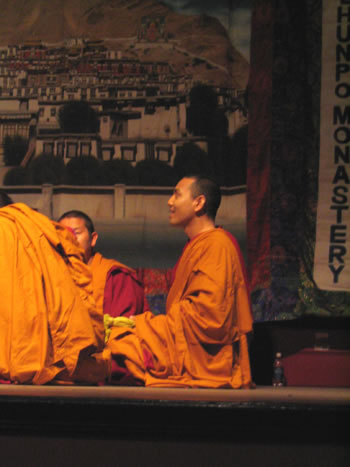
|
|
The last dance of the cham was probably my
favorite. It was Sha-Nak, the Dance of the Black Hat
Magicians. The Black Hat Dance usually lasts several hours and the dancers are in a trance while they perform it (this is probably true of all of the dances actually). We only saw an
excerpt of the dance. I loved the robes the dancers wore because of the face of Mahakala on them (remember Mahakala
from the heads of Avalokiteshvara?). The dance tells the story of Langdarma, a ninth century Tibetan king, who had conspired against Buddhism and wanted to help the Bön religion to come back into power in Tibet. Langdarma had Buddhists followed and killed. One day, the monk Pelkyi Dorje died his white horse black, rode to where some dancers were performing for Langdarma, and hid among
them, posing as a dancer. In the wide sleeves of his costume he had hidden
a bow and arrow with which, in the course of the dance, he killed the king. In the confusion that followed from that, he jumped on his horse and rode it through a river, which washed off the coal dust disguise and allowed Pelkyi Dorje to escape.
During the Sha-Nak dance that we saw, three
dancers entered the stage wearing enormous hats and colorful
robes. The hats obscured the faces of the dancers, and I
think that added to the mysterious and frightening look of the
robes with Mahakala's giant face on them. (These are a few
"artistic" pictures of the dance. And remember
that sometimes "artistic" can mean blurred.)
|
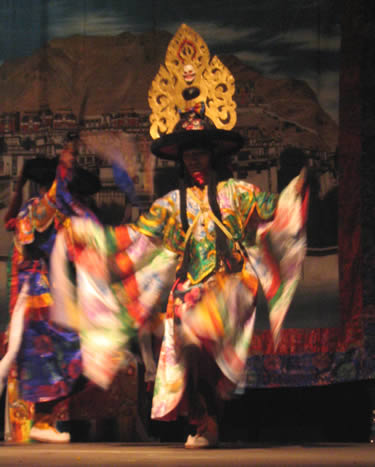 |
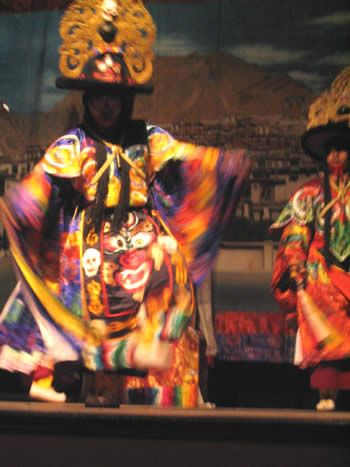 |
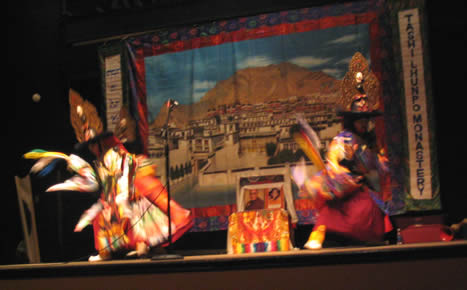 |
|
To close the cham, the monks performed Shijoe,
which is a chanting prayer dedicating the merits of the cham to
the well being of all living beings.
|
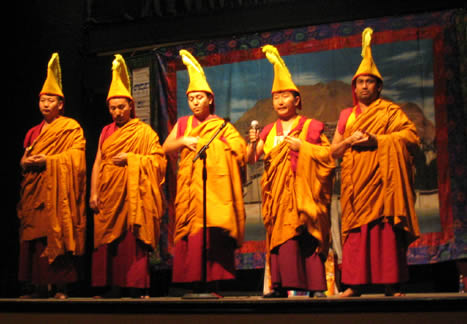 |
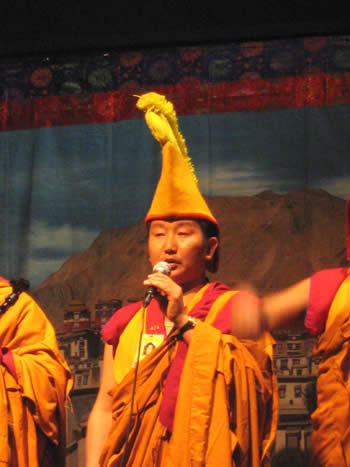 |
|
The monk in the picture above here, Ven. Lobsang
Norbu, became a favorite for my family. During the
dismantling of the peace mandala, he and my son were exchanging
smiles. Then a few days later on the day of the cham, he saw
my son and reached out to greet him, smiling and talking.
Again in a crowded room he did the same thing. This was
wonderful really to me and I wanted a good picture of him so we
wouldn't forget it. At the end of the cham he was putting
away the drums and I walked to him with my camera and asked if I
could get his picture, he said yes and then saw my son coming to
us and he smiled big and reached out gesturing for him to climb up
on stage too. I thought it a lovely thing and a connection
to this year's visit by the Tashi Lhunpo monks that we'll remember
for a long time.
|
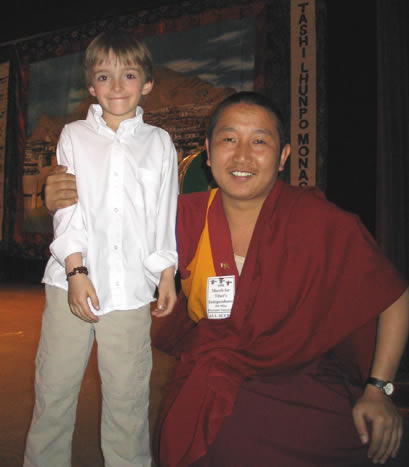 |
|
TASHI LHUNPO MONASTERY (Taken directly from a
handout we got at the cham)
Tashi Lhunpo Monastery, the principal monastery of
U-Tsang province of Tibet, is one of the Great Six centers of the
Gelugpa tradition. Tashi Lhunpo was founded by His Holiness
the 1st Dalai Lama, Gyalwa Gedun Drupe in 1447, and became the
largest, most vibrant monastery in Tibet. By 1959
there were more than 6,000 monks in residence at Tashi Lhunpo
Monastery in Shigatse, Tibet with another 2,000 monks affiliated
to the monastery living outside Tibet. Following the
Communist Chinese invasion of Tibet and the Cultural Revolution,
only 700-800 monks remaining in the monastery. Many monks
were killed or imprisoned. During the 1960s many
senior lamas and monks left Tibet and helped re-establish new
monasteries in India, Nepal and Bhutan. The 10th Panchen
Lama was not able to escape into exile and consequently many of
the senior lamas and monks form Tashi Lhunpo Monastery remained
inside Tibet. While other monasteries-in-exile have expanded
and developed, without the guidance of senior lamas Tashi Lhunpo
(which was re-established in the Southern Indian state of
Karnataka in 1972, under the guidance of His Holiness the 14th
Dalai Lama) is at a disadvantage and remains one of the poorest of
the re-established monasteries. The influx of refugees who
escape Tibet because of difficulties (imprisonment or death) they
face practicing Buddhism inside Tibet along with monks coming from
the Himalayan regions of Spithi, Khunu, Ladakh, Ghashar and
Sangkhar is putting a financial strain on the monastery. Tashi
Lhunpo Monastery is a non-profit charitable organization where
monks from Tibet, Bhutan, India, Nepal and China live in harmony
and are provided a community where they receive the best possible
modern education along with a deep and intimate understanding of
the heritage of Tibet. There are over 250 monks including
many Tulkus (reincarnate lamas) studying and performing various
religious practices living at the monastery. Tashi Lhunpo
Monastery aims to become a contributing member in spreading the
virtues of honesty, compassion and sacrifice, as taught by Lord
Buddha. |
|
Here are some good links to visit:
Tashi
Lhunpo Monastery website
The
Government of Tibet in Exile
Official
Dalai Lama website
Tibetan
Children's Village - Tibetan Children's Villages Tibetan
Children's Village (TCV) is an integrated community in exile for
the care and education of orphans, destitute and recently
escaped children from Tibet. It is a registered, non profit
charitable institution with its main organization based at
Dharamsala-North India. TCV has many branches spread across
India with over 11,000 children under its care.
Awakening
Buddha Foundation - To support programs and projects
designed to assist in the relief of the poor and distressed and
of the underprivileged, to promote the advancement of religion
and education, including and especially that of the Tibetan
Buddhism and its religious organizations located throughout the
world.
To
learn more about mandalas
and
even more |
|
|
|
|
|
|
|
|